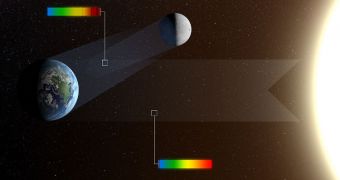A group of astronomers operating the European Southern Observatory's (ESO) Very Large Telescope (VLT), in Chile, was recently able to discover life on Earth. While that's nothing new, the method they used to do so definitely is.
According to a research paper they published in the March 1 issue of the top scientific journal Nature, a phenomenon called earthshine can be used in combination with a series of other observation methods to reveal the existence of biosignatures on a celestial body.
Even though the research was carried out on Earth, the astronomers assure that the same basic principle applies even when it comes to extrasolar planets as well. Scientists have been looking for possible methods to detect alien life for quite some time, but our technologies are rather primitive.
Though our telescope can easily discover exoplanets around distant stars, they are not yet advanced enough to study the atmosphere of Earth-like worlds. With the launch of the NASA James Webb Space Telescope, in 2018, this may become possible.
“We used a trick called earthshine observation to look at the Earth as if it were an exoplanet. The Sun shines on the Earth and this light is reflected back to the surface of the Moon,” ESO investigator and lead paper author Michael Sterzik explains.
“The lunar surface acts as a giant mirror and reflects the Earth’s light back to us – and this is what we have observed with the VLT,” he adds. The VLT is one of the best optical telescopes in the world. It combines light from four main telescopes and four tracking telescopes into a single image.
An added benefit of applying this research technique to our research planet is that the team also created a frame of reference. We know for a fact that life exists here, so the earthshine blueprint our planet generates should be used as decisive factor when analyzing other worlds.
The astronomers also used an observations technique spectropolarimetry to conduct the new study. This approach analyzed not only the the color of light waves returning from the Moon, but also their polarization. The latter is a parameter that can encode vast volumes of data.
“The light from a distant exoplanet is overwhelmed by the glare of the host star, so it’s very difficult to analyze – a bit like trying to study a grain of dust beside a powerful light bulb. But the light reflected by a planet is polarized, while the light from the host star is not,” the research team explains.
“So polarimetric techniques help us to pick out the faint reflected light of an exoplanet from the dazzling starlight,” the scientists conclude.

 14 DAY TRIAL //
14 DAY TRIAL //